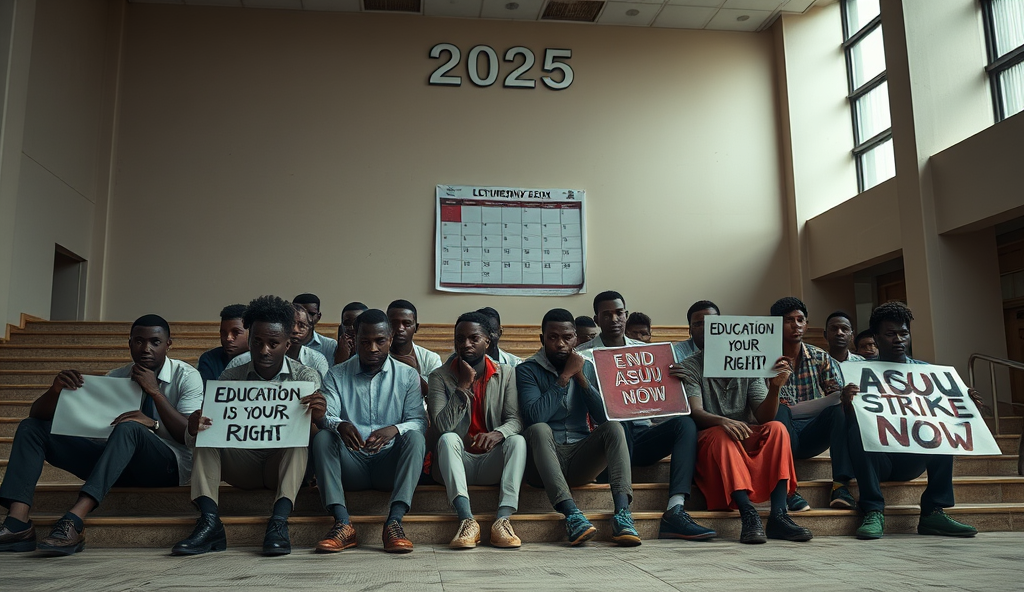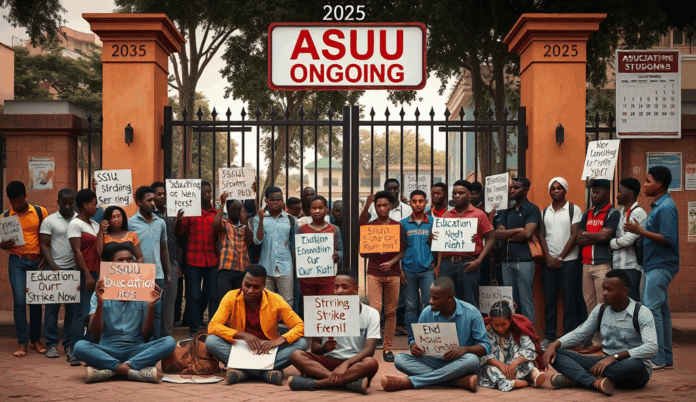Introduction to the ASUU Strike in Nigeria 2023
The 2023 ASUU strike marked another disruptive chapter in Nigeria’s higher education crisis, with universities shut for over eight months. This industrial action, led by the Academic Staff Union of Universities, directly impacted over 1.5 million students nationwide, compounding existing academic delays from previous strikes.
Key issues fueling the 2023 strike included unmet government agreements from 2009 and 2020, particularly concerning funding and staff welfare. Students faced prolonged uncertainty as negotiations stalled, with many forced to seek alternatives like private institutions or online learning.
Understanding these recurring strikes requires examining their root causes, which have persisted despite temporary resolutions. The next section will analyze the specific triggers behind the 2023 ASUU strike and their implications for Nigeria’s education system.
Key Statistics

Causes of the ASUU Strike in Nigeria 2023
The 2023 ASUU strike marked another disruptive chapter in Nigeria's higher education crisis with universities shut for over eight months
The 2023 ASUU strike primarily stemmed from the federal government’s failure to implement the 2009 agreement, which promised improved funding for universities and better working conditions for lecturers. Key unresolved demands included the revitalization of public universities with ₦1.3 trillion and the adoption of the University Transparency and Accountability Solution (UTAS) for salary payments.
Another major trigger was the non-payment of earned academic allowances, totaling over ₦40 billion, despite repeated promises since 2020. Lecturers also protested the government’s insistence on using the Integrated Payroll and Personnel Information System (IPPIS), which ASUU argued compromised university autonomy and caused salary irregularities.
These systemic issues, compounded by inflation and deteriorating infrastructure, forced lecturers to strike after exhausting negotiation options. The prolonged industrial action’s consequences, particularly for students, will be examined in the next section.
Impact of the ASUU Strike on Nigerian University Students
Key unresolved demands included the revitalization of public universities with ₦1.3 trillion and the adoption of the University Transparency and Accountability Solution (UTAS) for salary payments
The 2023 ASUU strike disrupted academic calendars for over 1.5 million students across federal universities, with many institutions losing an entire semester. Prolonged closures forced students into unplanned breaks, exacerbating mental health challenges and financial strain from extended rent payments in school towns.
Final-year students faced delayed graduations, missing NYSC mobilization and job opportunities, while medical students struggled with clinical rotations. The strike also widened educational inequalities as only wealthier students could afford private universities or alternative learning platforms.
These disruptions intensified calls for education reform, setting the stage for examining the government’s response to the crisis in the next section.
Government Response to the ASUU Strike in 2023
Prolonged closures forced students into unplanned breaks exacerbating mental health challenges and financial strain from extended rent payments in school towns
The federal government initially adopted a hardline stance, with the education minister insisting strike actions wouldn’t force increased funding amid competing national priorities. However, mounting public pressure and student protests across campuses forced a shift, leading to the formation of a presidential committee to renegotiate with ASUU in October 2023.
Government offered partial concessions, including a 35% salary increase for lecturers and N50 billion revitalization fund, but rejected demands for full autonomy in university management. These measures failed to immediately resolve the strike, as ASUU argued the proposals didn’t address core issues like earned academic allowances and infrastructure decay.
The prolonged deadlock revealed systemic challenges in Nigeria’s education budgeting, with only 5.3% of the 2023 budget allocated to education – far below UNESCO’s recommended 15-20%. This funding gap set the stage for deeper discussions about ASUU’s fundamental demands, which we’ll examine next.
ASUU Demands and Negotiations in 2023
Government offered partial concessions including a 35% salary increase for lecturers and N50 billion revitalization fund but rejected demands for full autonomy in university management
ASUU’s 2023 demands centered on full implementation of the 2009 agreement, including payment of N1.3 trillion in earned academic allowances and N200 billion yearly revitalization funds for universities, contrasting sharply with the government’s N50 billion offer. The union also sought university autonomy to prevent frequent federal interference in academic affairs, a demand the government rejected citing concerns over accountability.
Negotiations stalled over infrastructure decay, with ASUU citing UNESCO data showing Nigeria’s public universities need over N1.9 trillion to meet global standards, while the 2023 budget allocated just N1.79 trillion to entire education sector. This funding disparity fueled ASUU’s insistence on binding commitments rather than temporary solutions.
The deadlock persisted as ASUU rejected the 35% salary increase, arguing it didn’t match inflation rates exceeding 25% or address lecturers’ eroded purchasing power since 2009. These unresolved issues set the stage for ongoing strike actions, which we’ll explore in the latest updates section.
Latest Updates on the ASUU Strike in Nigeria 2023
Facing indefinite academic delays over 60% of students now pursue online certifications or vocational training with platforms like Coursera and ALX reporting 40% more Nigerian enrollments since the strike began
As of October 2023, ASUU remains on strike despite government offers, with both parties failing to bridge the N1.3 trillion funding gap for earned allowances and university revitalization. The union maintains its stance, citing the 35% salary increase as insufficient against Nigeria’s 25.8% inflation rate and rising living costs.
Recent negotiations collapsed when the government proposed staggered payments for outstanding allowances, which ASUU rejected as another temporary measure. Student protests have intensified across campuses, with the National Association of Nigerian Students (NANS) threatening nationwide demonstrations if resolutions aren’t reached before December.
The prolonged strike has disrupted academic calendars, pushing graduation timelines for over 2.1 million students into 2024. This uncertainty has forced many students to explore alternatives, a reality we’ll examine in the next section on coping strategies during the ASUU strike.
How Nigerian University Students Are Coping with the Strike
Facing indefinite academic delays, over 60% of students now pursue online certifications or vocational training, with platforms like Coursera and ALX reporting 40% more Nigerian enrollments since the strike began. Some undergraduates have turned to internships, leveraging the pause to gain work experience in sectors like tech and finance, though opportunities remain scarce for non-urban students.
In Lagos and Abuja, student-led study groups meet weekly to review course materials, while others collaborate via WhatsApp and Telegram to maintain academic momentum. However, rural students struggle with inconsistent electricity and internet access, widening the educational divide exacerbated by the ASUU strike’s prolonged disruption.
With NANS protests escalating, some students are joining advocacy efforts, petitioning lawmakers and organizing media campaigns to pressure both ASUU and the government. As frustration grows, these coping mechanisms highlight the urgent need for resolutions, which we’ll explore in the next section on potential solutions to end the strike.
Possible Solutions to End the ASUU Strike
The government could adopt a phased implementation of ASUU’s demands, prioritizing urgent needs like salary increments and infrastructure funding, as seen in the 2022 agreement with the University of Ibadan’s branch. Mediation by neutral bodies like the National Industrial Court or respected academics could break the deadlock, similar to the 2020 intervention that temporarily resolved the strike.
Students’ advocacy efforts, including NANS protests and social media campaigns, must intensify to pressure both parties, leveraging public sentiment as seen during the #EndASUUStrike movement. Increased transparency in negotiations, with regular updates shared through official channels, would rebuild trust and prevent misinformation from fueling tensions.
Finally, alternative funding models like education bonds or public-private partnerships could address budget shortfalls, as proposed by stakeholders during the 2023 National Education Summit. While these solutions require compromise, their implementation could prevent further disruptions to Nigeria’s academic calendar and student futures.
Conclusion on the ASUU Strike in Nigeria 2023
The 2023 ASUU strike, lasting over eight months, disrupted academic calendars across Nigerian universities, leaving students in limbo and compounding existing challenges in the education sector. Despite partial resolutions, key issues like funding and welfare remain unresolved, signaling potential future disruptions if not addressed comprehensively.
Student protests and public outcry highlighted the strike’s broader societal impact, with many calling for systemic reforms to prevent recurrent industrial actions. Government negotiations yielded temporary solutions, but long-term stability demands sustained dialogue and policy implementation.
As stakeholders await concrete actions, the 2023 strike serves as a reminder of Nigeria’s urgent need for education sector revitalization. The next phase will determine whether lessons from this disruption translate into meaningful change or another cycle of unrest.
Frequently Asked Questions
How can Nigerian students continue learning during ASUU strikes?
Explore online platforms like Coursera or ALX for certifications and join student-led study groups on WhatsApp to maintain academic momentum.
What practical steps can students take to pressure ASUU and the government?
Join NANS-organized protests and use social media campaigns with #EndASUUStrike to amplify demands for resolution.
Are there alternative funding models that could prevent future ASUU strikes?
Advocate for public-private partnerships in education through student unions and engage lawmakers on education bond proposals.
How can final-year students minimize career setbacks from strike delays?
Pursue internships in tech or finance sectors and document skills via LinkedIn to stay competitive despite graduation delays.
What coping strategies help rural students during prolonged ASUU strikes?
Form local study groups with printed materials and leverage offline learning apps like Khan Academy Lite for low-internet areas.


